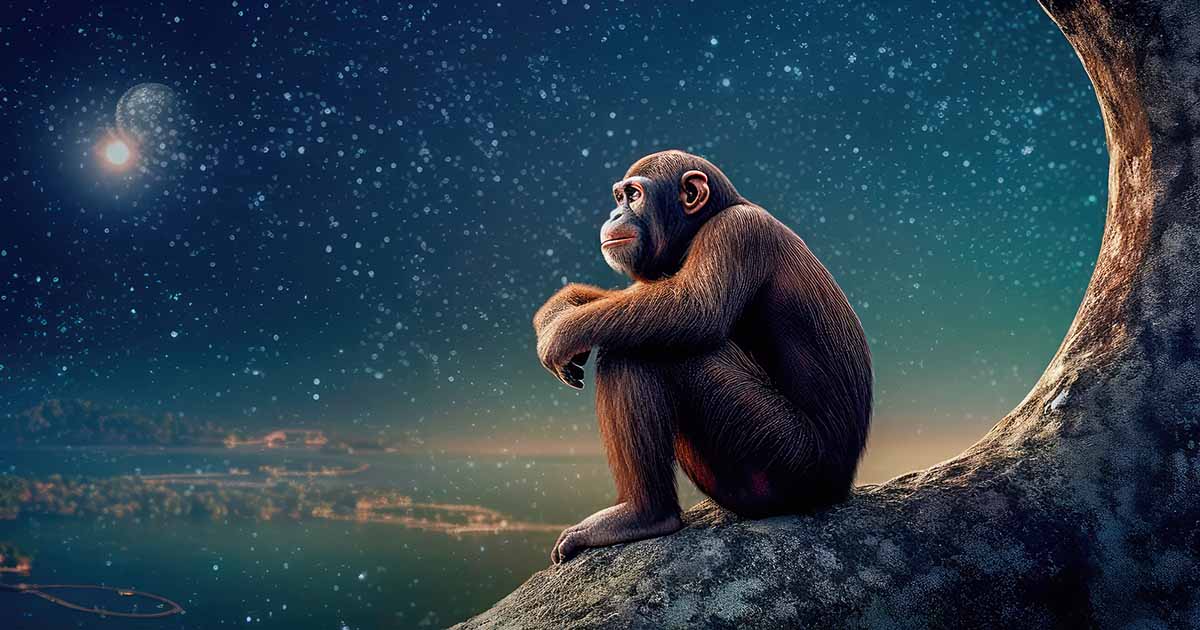Age of the Wise Men: What Distinguishes Homo Sapiens from Apes?
Homo sapiens represents the last of a long line of hominins that once consisted of five different species spanning four continents. Today, we are the last humans, that is, the last of the genus Homo. Our closest living relatives are chimpanzees and gorillas. We do, however, stand out in many ways from them. We have unparalleled capacities for abstract thought, language skills, and social cohesion. Over the decades, scientists have found that many of these human abilities are shared by other great apes, though to less impressive degrees. This leads to a question. What makes Homo Sapiens different from other ape species?
Current research suggests that the difference between humans and other great apes is more one of degree than one of kind. Other animals, including great apes and dolphins, have capacities for abstract thought and language skills but these abilities are especially pronounced in Homo Sapiens. The areas in which we excel compared to other great apes include material culture production, social learning, altruism, and language skills.
Material Culture of Homo Sapiens
Archaeologists agree on very few things regarding humans, but one thing on which they do agree is that all humans possess culture, including material culture. Material culture consists of objects which were intelligently produced or altered by humans, or other sapient beings for some purpose.
The earliest evidence of human material culture is represented by stone tools made 2.5 million years ago by Homo Habilis, the first member of the genus Homo, the earliest human species. The first human species to embrace material culture as a primary way to adapt to its environment was Homo Ergaster which had a notably more complex array of stone tools than Homo Habilis, though the tools made by Homo Ergaster were still primitive compared to those developed later by Homo Sapiens.
- Teeth Discovered in China Show that Modern Humans Left Africa at Least 30,000 Years Earlier than Previously Thought
- Are Humans Just Self-Domesticated Apes?

NYC Spitzer Hall of Human Origins - Homo Ergaster, dating back 2 million years. (Wally Gobetz/CC BY-NC-ND 2.0)
Material culture made by Homo Sapiens is even more prolific and complex. Spear-throwers, needles, blades, paintings, bows, wheels, steam engines, cellphones, and rockets are all examples of material culture that have only been made by Homo Sapiens ( or modern humans). Modern humans have been able to use their versatile toolmaking abilities to adapt to almost every known climatic regime and environment from tropical rainforests, to tundra, to outer space.
Chimpanzees are also capable of making technology, but chimp technology appears to be limited to simple sticks and stones. There is evidence that chimpanzees occasionally sharpen sticks into spears, but these simple spears so far appear to represent the cutting edge of chimpanzee technological development. The story is the same for other great apes besides humans. Compared to Homo Sapiens and other human species, the archaeological record of great ape technology is almost blank.

Use of sticks and stones is the height of chimpanzee technological advancement (Ucumari photography/CC BY NC-ND 2.0)
Learning for Learning’s Sake
Another trait that is distinctive in humans compared to great apes is the degree to which humans can learn through social behavior. Experiments have shown that both human infants and chimpanzees learn by imitation. An important difference between chimpanzees and Homo Sapiens, however, is that although chimpanzees will learn rewarded behavior, they tend to skip unrewarded behavior. In other words, chimpanzees will engage in behaviors that they know will help them to attain their goal, but if a behavior does not get them closer to their goal, they will quickly discard or skip the behavior.
Human infants, on the other hand, will not just imitate the rewarded behaviors but also unrewarded behaviors. It appears that, whereas chimpanzees will imitate behavior because the behavior is useful in getting a reward, humans will imitate behavior to learn how to behave like other humans. Human infants will also internalize learned behavior and have an emotional reaction when a task that they were taught to do is done differently or “the wrong way” by someone else.

Other apes learn from imitation, but infant apes will only imitate rewarded behavior. Human’s infants will imitate behavior with no reward. (Pierre Fidenci/CC BY-SA 2.5)
Homo Sapiens – The Overly Social Ape
This capacity for social learning demonstrates how, even compared to other apes, humans are highly social. Another example of this is human altruism. Chimpanzees, for example, for the most part only exhibit altruism towards their own kin-group, and, even then, female chimpanzees will not readily share with their own offspring.
Humans, on the other hand, will engage extensively in helping and sharing with non-kin. Experimental economics has shown that there are cases where human behavior contradicts the model in market economics and evolutionary biology that individuals are essentially selfish and self-interested. In games used to test theories about human nature in economics, humans will often choose options that favor cooperation and generosity over options that will give the individual an advantage over the group. Chimpanzees subjected to similar tests almost always choose the option that gives the individual more advantage. Although other great apes are capable of altruism, their altruism appears limited compared to human altruism.

Humans show more altruism than other species. Source: MP Studio / Adobe Stock.
Linguistic Maestros
Another trait that makes humans different in many ways from other great apes is an unusually advanced capacity for language. Research on great ape language have shown that gorillas, chimpanzees, and orangutans all have a capacity for language. Many apes have learned sign language in captivity and learned it in the same way that human toddlers acquire language. Despite this impressive accomplishment, chimpanzees, gorillas, and orangutans taught language have never gone beyond the stage of learning of a human toddler. Adult great ape linguistic and cognitive skills outside of Homo Sapiens seem to be forever frozen at the level of a human preschooler. Although Homo Sapiens is not the only species capable of using the language, modern humans are the only ones to have taught themselves grammatical language. All other great apes who use language had to be taught to use it by humans.

Language use has been developed and taught by Homo Sapiens. (Nenad Stojkovic/CC BY 2.0)
In contrast to apes, who for the most part do not even use language as we understand it in the wild, language is deeply ingrained in human thought and behavioral patterns. It is embedded to such a degree that most social situations that we think of as normal would not exist without language. Games, classes, celebrations, and religious ceremonies are all examples of human social events that would either not exist or look very different without language. It could be said that humans are as much linguistic animals as they are social or cultural animals.
- Mysterious Origins – What we don’t know about the emergence of humans
- DNA Evidence Suggests Captured Russian Ape Woman Might Have been Subspecies of Modern Human
Homo Sapiens Sophistication
Most human traits are found in lesser degrees in other species. What makes humans unique however is the degree to which the trait is possessed or the way in which it is used. Humans, compared to other apes, are highly social, primarily use culture to adapt to their environment, and are very skilled at language. The reason why all these traits became so pronounced in humans is not entirely clear, but all these traits have allowed humans to be much more adaptable and resilient in the face of a changing environment. It could be that rapid environmental changes related to the fluctuating climate in the Pleistocene helped to produce these traits in humans over time, culminating in Homo Sapiens.
A study published in the journal Science Advances in 2021 found that only about 7% of the human genome is unique to our species. The rest of our DNA is shared with other hominins, such as Neanderthals and Denisovans.
The study's authors analyzed the DNA of over 1,000 people from around the world, as well as the DNA of Neanderthals and Denisovans. They found that the genes that are unique to humans are involved in a variety of functions, including brain development, immunity, and metabolism.
The study's authors conclude that the uniqueness of humans is not due to a single gene or set of genes. Instead, it is likely due to a combination of genetic and environmental factors.
Top image: A chimpanzee in contemplation. Source: keks20034 / Adobe Stock.
By Caleb Strom


















Comments
You wrote that closest living relatives are chimpanzees and gorillas. I have heard that bonobos are, with chimpanzees being second.